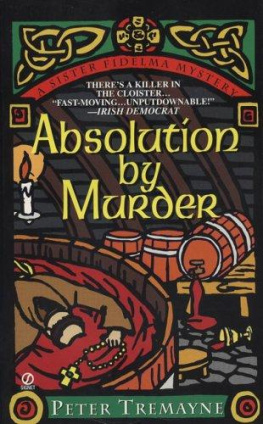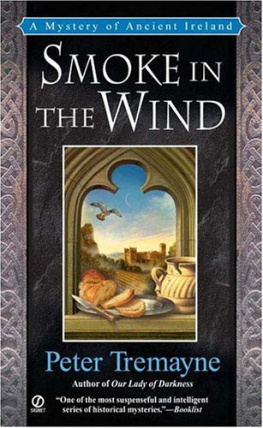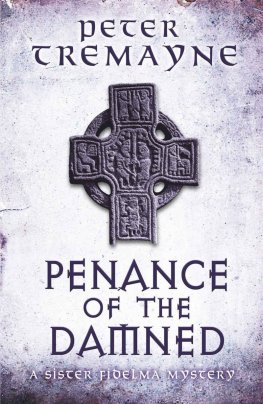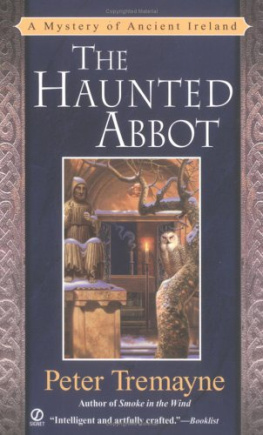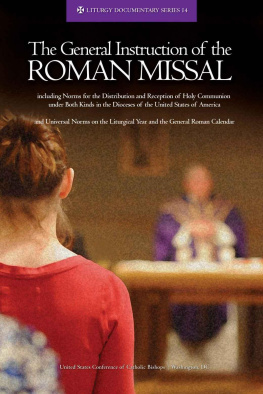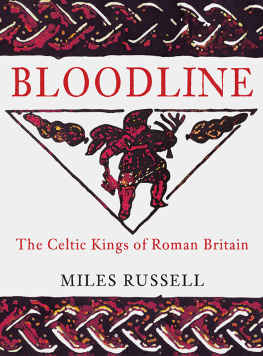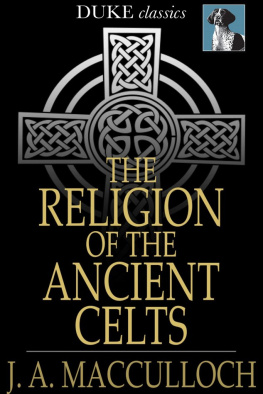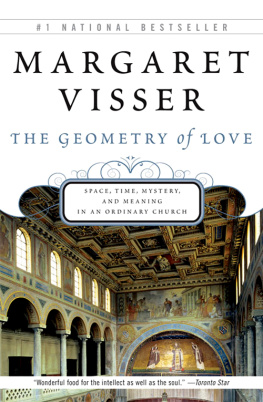CRITICAL PRAISE FOR ABSOLUTION BY MURDER and Peter Tremayne "If you have not yet encountered Sister Fidelma, it will only be a matter of time. Tremayne uses many real characters and events as background, making the events all the more convincing and fascinating.... He succeeds admirably in bringing the ancient world to life."- Mystery Scene "... takes us into a world that only an author steeped in Celtic history could recreate so vividly-and one which no crime novelist has explored before. Make way for a unique detective." -Peter Haining, ed., Great Irish Detective Stories "A Brother Cadfael on the distaff side." - Oxford Times "Sister Fidelma promises to be one of the most intriguing new characters in 1990's detective
fiction."
Book and Magazine Collector "Entertaining... vivid ... invigorating and stimulating.... A seventh-century nun who solves murder mysteries in settings of
ecclesiastical grandeur."
Belfast Andersonstown News I "Intriguing characters ... a sharp-tongued heroine bar
whom many readers will willingly follow."
Kirkus Reviews "The background detail is marvelous ... definitely an Ellis Peters competition."- Evening Standard "The plots are as clever as Fidelma, but the real
attraction is Tremayne's feel for the period."
Manchester Evening News "The literary successor to Ellis Peters" Brother Cadfael!" -Cork, Ireland, Southern Star "Difficult to put down! It is reassuring to read that Sister Fidelma will reappear." -Publishers Weekly "A fast-moving whodunit!"- Irish Democrat A Sister Fidelma Mystery Peter Tremayne A SIGNET BOOK To Dorothea SIGNET Published by New American Library, a division of Penguin Putnam Inc., 375 Hudson Street, his, New York, New York 10014, U.s.a. Penguin Books Ltd, 27 Wrights Lane, London W8 5TZ, England Penguin Books Australia Ltd, Ringwood, Victoria, Australia Penguin Books Canada Ltd, 10 Alcorn Avenue, Toronto, Ontario, Canada M4V 3B2 Penguin Books (n.z.) Ltd, 182-190 Wairau Road, Auckland 10, New Zealand Penguin Books Ltd, Registered Offices: Harmondsworth, Middlesex, England Published by Signet, an imprint of New American Library, a division of Penguin Putnam Inc. This is an authorized reprint of a hardcover edition published by St. Martin's Press. For information address St. Martin's Press, 175 Fifth Avenue, New York, NY 10010. First published in Great Britain by Headline Books Publishing. First Signet Printing, September 1997 10 9876543 tilde Copyright [ copygg'Peter Tremayne, 1994 All rights reserved REGISTERED TRADEMARK-MARCA REOISTRADA Printed in the United States of America Without limiting the rights under copyright reserved above, no part of this publ. cation may be reproduced, stored in or introduced into a retrieval system, or transmitted, in any form, or by any means (electronic, mechanical, photocopying, recording, or otherwise), without the prior written permission of both the copyright owner and the above publisher of this book. Fidelma's World The Sister Fidelma mysteries are set during the mid- seventh century AD. Sister Fidelma is not simply a religieuse, a member of the community of St. Brigid of Kildare. She is also a qualified ddlaigh, or advocate of the ancient law courts of Ireland. As this background will not be familiar to many readers, this foreword provides a few essential points of reference designed to make the stories more readily appreciated. Ireland, in the seventh century ad, consisted of five main provincial kingdoms: indeed, the modern Irish word for a province is still cuige, literally "a fifth." Four provincial kings-of Ulaidh (ulster), of Connacht, of Muman (munster) and of Laigin (leinster)-gave their %greater-than allegiance to the Ard Ri or High King, who ruled from Tara, in the "royal" fifth province of Midhe (meath), dis.wh means the "middle province." Even among these provincial kingdoms, there was a decentralization of " power to petty-kingdoms and clan territories. The law of primogeniture, the inheritance by the eldest son or daughter, was an alien concept in Ireland. Kingship, from the lowliest clan chieftain to the High King, was only partially hereditary and mainly electoral. Each ruler had to prove himself or herself worthy of office and was elected by the derbfhine of their family- Of Sister Fidelma's World three generations gathered in conclave. If a ruler did not pursue the commonwealth of the people, they were impeached and removed from office. Therefore the monarchial system of ancient Ireland had more in common with a modern-day republic than with the feudal monarchies of medieval Europe. Ireland, in the seventh century ad, was governed by a system of sophisticated laws called the Laws of the Fenechas, or landtillers, which became more popularly known as the Brehon Laws, deriving from the word breitheamh- a judge. Tradition has it that these laws were first gathered in 714 be by the order of the High King Ollamh Fodhla. But it was in AD 438 that the High King Laoghaire appointed a commission of nine learned peo- m pie to study, revise and commit the laws to the new writ ing in Latin characters. One of those serving on the commission was Patrick, eventually to become patron saint of Ireland. After three years, the commission produced a written text of the laws, the first known codification. The first complete surviving texts of the ancient laws . of Ireland are preserved in an eleventh-century manuscript book. It was not until the seventeenth century that the English colonial administration in Ireland finally suppressed the use of the Brehon Law system. To even possess a copy of the law books was punishable, often by death or transportation. The law system was not static and every three years at the F6is Temhrach (festival of Tara) the lawyers and administrators gathered to consider and revise the laws in the light of changing society and its needs. Under these laws, women occupied a unique place. The Irish laws gave more rights and protection to women than any other western law code at that time or since. Women could, and did, aspire to all offices and professions as the coequal with men. They could be political leaders, command their people in battle as warriors, be physicians, local magistrates, poets, artisans, lawyers and judges. We know the name of many female judges of Fidelma's period-Brig Briugaid, Aine Ingine lugaire and Dari among many others. Dari, for example, was not only a judge but also the author of a noted law text written in the sixth century ad. Women were protected by the laws against sexual harassment; against discrimination; from rape; they had the right of divorce on equal terms from their husbands with equitable separation laws and could demand part of their husband's property as a divorce settlement; they had the right of inheritance of personal property and the right of sickness benefits. Seen from today's perspective, the Brehon Laws provided for an almost feminist paradise. This background, and its strong contrast with Ireland's neighbors, should be understood to appreciate Fidelma's role in these stories. Fidelma was born at Cashel, capital of the kingdom of Muman (munster) in south-west Ireland, in ad 636. She was the youngest daughter of Failbe Fland, the king, who died the year after her birth and was raised under the guidance of a distant cousin, Abbot Laisran of Dur- row. When she reached the "Age of Choice" (fourteen years), she went to study at the bardic school of the Brehon Morann of Tara, as many other young Irish girls did. Eight years of study resulted in Fidelma obtaining the degree ofAnruth, only one degree below the highest offered at either bardic or ecclesiastical universities in ancient Ireland. The highest degree was ollamh, still the modern Irish word for a professor. Fidelma's studies were in law, both in the criminal code of the Senchus Mdr and the civil code of the Leabhar Acaill. She therefore became a ddlaigh or advocate of the courts. Her role could be likened to a modem Scottish sheriff- substitute, whose job is to gather and assess the evidence, independent of the police, to see if there is a case to be answered. The modern French juge d'instruction holds a similar role. In those days, most of the professional or intellectual classes were members of the new Christian religious houses, just as, in previous centuries, all members of professions and intellectuals were Druids. Fidelma became a member of the religious community of Kildare founded in the late fifth century ad by St. Brigid. While the seventh century ad was considered part of the European "Dark Ages," for Ireland it was a period of "Golden Enlightenment." Students from every corner of Europe flocked to Irish universities to receive their education, including the sons of the Anglo-Saxon kings. For @l example, Aldfrith, who became king of Northumbria from ad 685-705, was educated at Bangor and achieved a reputation in Ireland as a poet in the Irish language. f Three of his poems still survive in ancient texts. At the great ecclesiastical university of Durrow, at this time, it is recorded that no less than eighteen different nations were represented among the students. At the same time, Irish male and female missionaries were setting out to reconvert a pagan Europe to Christianity, establishing churches, monasteries and centers of learning throughout Europe as far east as Kiev, in the Ukraine; as far north as the Faroes, and as far south as Taranto in southern Italy. Ireland was a by-word for literacy and learning. However, the Celtic Church of Ireland was in constant dispute with Rome on matters of liturgy and ritual. Rome had begun to reform itself in the fourth century, changing its dating of Easter and aspects of its liturgy. The Celtic Church and the Eastern Orthodox Church refused to follow Rome but the Celtic Church was gradu- I Sister Fidelma's Worldix ally absorbed by Rome between the ninth and eleventh centuries while the Eastern Orthodox Churches have continued to remain independent of Rome. The Celtic Church of Ireland, during Fidelma's time, was much concerned with this conflict. The first Fidelma mystery, Absolution By Murder, is set against the most famous debate between the representatives of the Celtic and Roman Churches at Whitby in ad 664. One thing that marked both the Celtic Church and Rome in the seventh century was that the concept of celibacy was not universal. While there were always ascetics in both churches who sublimated physical love in a dedication to the deity, it was not until the Council of Nicea in ad 325 that clerical marriages were condemned but not banned. The concept of celibacy in the Roman Church arose from the customs practiced by the pagan priestesses of Vesta and the priests of Diana. By the fifth century Rome had forbidden clerics from the rank of abbot and bishop to sleep with their wives and, shortly after, even to marry at all. The general clergy were discouraged from marrying by Rome but not forbidden to do so. Indeed, it was not until the reforming papacy of Leo IX (ad 1049-1054) that a serious attempt was made to force the western clergy to accept universal celibacy. In the Eastern Orthodox Church, priests below the rank of abbot and bishop have retained their right to marry until this day. The condemnation of the "sin of the flesh" remained "alien to the Celtic Church for a long time after Rome's 1 attitude became a dogma. In Fidelma's world, both sexes inhabited abbeys and monastic foundations which were known as conhospitae, or double houses, where men and women lived raising their children in Christ's service. Fidelma's own house of St. Brigid of Kildare was one

